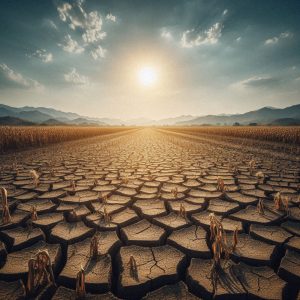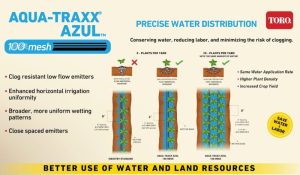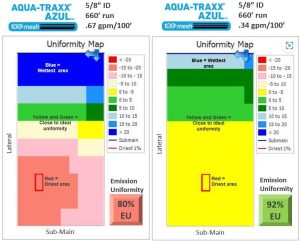Source: The Western Producer
Written by Ron Lyseng
Posted August 6, 2015

Using sprinkler irrigation to apply fertilizer and pesticides has been around for a while.
However, root feeding chemicals by soil-injecting them through sub-soil irrigation is probably a new idea to many prairie farmers.
The practice of applying chemicals through buried drip irrigation lines has been used for decades in fruit and vegetable crops and orchards. Subsurface drip irrigation (SDI) is pumping water into perforated poly pipes buried deep enough in the soil so that they’re not bothered by seeding and tillage equipment.
Inge Bisconer, a technical manager in Toro’s Micro-Irrigation division, said Toro has been an early developer of SDI.
However, drip irrigation is no longer exclusive to small-acreage, high-value horticulture crops.
Bisconer said hundreds of thousands of acres of alfalfa, soybeans, corn and other broad-acre field crops that were previously irrigated with centre pivots or gravity systems are now irrigated with SDI in the United States.
For many irrigation producers, it was a matter of changing the way they farmed or get out of farming.
Arizona farmer Rob Knorr is shifting from pivot to drip irrigation to feed his crops, including yellow peas and durum.
“The systems are more water and nutrient efficient,” he said.
Knorr said the practice also reduces fungal development above the soil in many cases.
Drought in the western U.S. has resulted in water rationing and higher fees, which have prompted producers to shift to more efficient practices.
Bisconer said the reductions have been substantial.
“During the drought, farmers are under water allocation of less than 16 inches (400 millimetres) of water per year,” he said.
“They quickly found out they couldn’t grow a crop with that amount of water if they put it through a pivot. They were losing too much water through the air, through evaporation. One of our customers in Texas found he could grow just as much cotton on an 80 acre drip system as he could on a 120 acre pivot system and use less water in doing so.”
Cost had once prevented grain farmers and forage producers from considering subsurface irrigation, but they began to change their mind when they saw how it benefited neighbours specializing in crops such as potatoes, onions and tomatoes.
It became obvious that SDI used less water, which meant lower energy costs. Putting water directly into the root zone also resulted in better yields and allowed farmers to apply all their fertility inputs, as well as many of their crop protection products, through the system.
Broad acre grain farmers in the southwestern U.S. saw that SDI simplified the application process because fertilizer could now be applied only as needed.
Foliar crop protection still had to be applied through irrigation pivots, high clearance sprayers or aerial applicators, but some crop protection products could now go through the SDI.
Cost was still a hurdle, but Bisconer said the benefits of subsurface irrigation were strong enough to motivate grain farmers to consider it.
A basic SDI system for broad acre field crops costs US$1,100 to $1,300 per acre, which excludes the pumps but includes, filters, controls, in-ground perforated poly pipe and the ability to apply chemicals.
A producer who needs full automation with sensors, monitors and remote controls can pay as much as $2,000 per acre.
Farmers can expect the in-ground lines to last 10 to 20 years, depending on pipe thickness or the tape system that is used.
They are typically buried 12 to 18 inches deep but can go as deep as three feet in special situations.
“A really big factor in determining cost is the degree of water filtration you require,” she said.
“How dirty is the water source? If the water needs a lot of cleanup, there’s an equipment cost up front plus your on-going energy cost to push dirty water through more filters. Dividing a field into smaller blocks also adds to your cost.
“Higher levels of automation may cost more up front, but that reduces labour and management costs in the long run. If you want the capability to run more water more quickly, that will cost more because of more pump power. The positive side is that it might allow you to irrigate more fields with bigger pumps.
“Another big cost consideration is how close you need to run your lateral drip lines. Wide spacing costs less than close spacing, but the soil really is the determining factor. Customers install systems with lateral spacing anywhere from 30 inches to 80 inches, depending on the soil. With a sandy soil, you need the lines to be closer because water runs downward. You can get by with wider spacing in heavier soils.”
Bisconer said the switch by corn growers from pivot irrigation to subsurface irrigation speaks loudly for subsurface systems. Corn is a significant consumer of water and nitrogen, she added.
Toro works with customers to develop ways to document water use.
Bisconer said moisture monitoring runs from the basics of going out with a shovel to high tech moisture meters. The tensiometer measures how hard the plant roots have to work to extract moisture from the soil. It gives an accurate reading on soil water quantity .
Plant roots work hard and waste a lot of energy trying to use saline water.
“The beauty of drip irrigation is that you can make those irrigation water deposits on a daily basis or even an hourly basis if you want,” she said.
“You deposit only the exact amount you want. It’s like spoon feeding the crop. And it’s accurate because you know there’s no water being lost to the wind or evaporation.
“There are many registered chemicals that growers have been applying through drip for insect and disease management. It’s quite common. I’d guess that a quarter of all drip irrigation farmers are running some sort of crop protection chemicals or fertilizers through the system.”
Article by Ron Lyseng via The Western Producer




